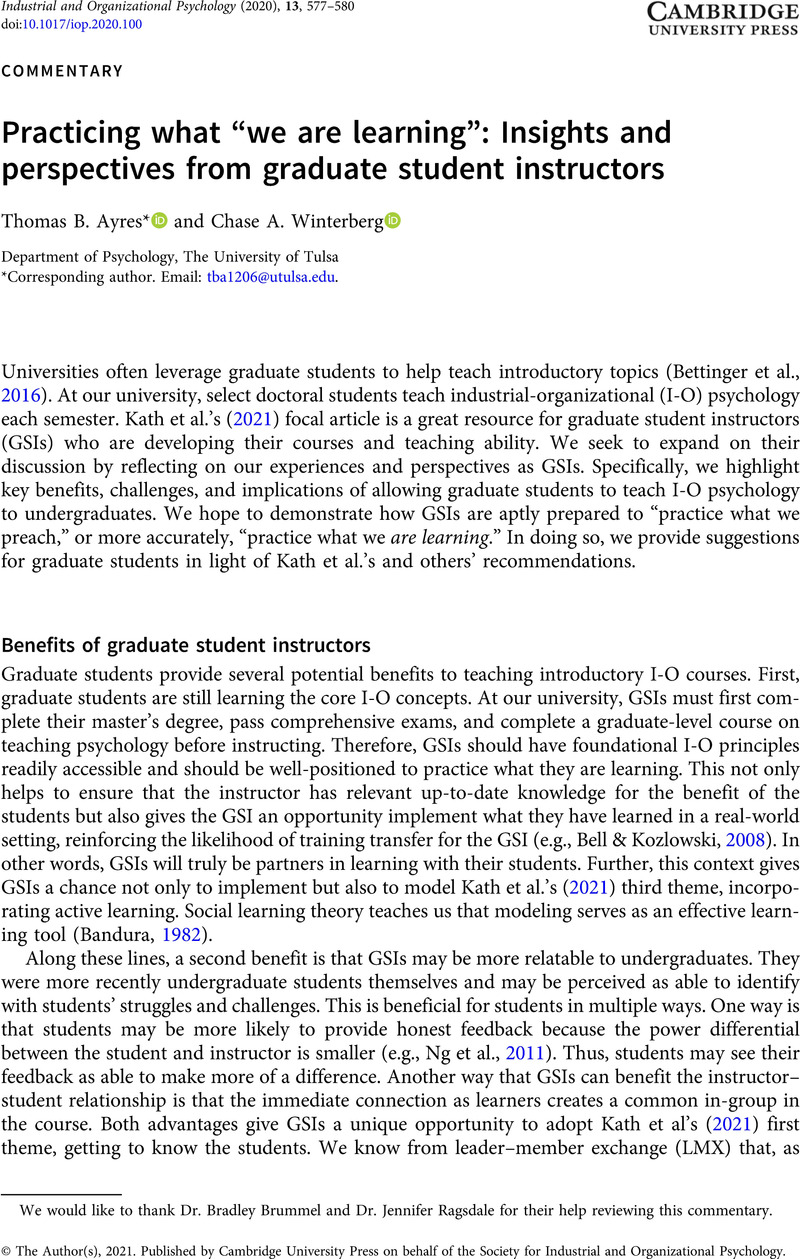No CrossRef data available.
Article contents
Practicing what “we are learning”: Insights and perspectives from graduate student instructors
Published online by Cambridge University Press: 08 February 2021
Abstract
An abstract is not available for this content so a preview has been provided. Please use the Get access link above for information on how to access this content.

- Type
- Commentaries
- Information
- Copyright
- © The Author(s), 2021. Published by Cambridge University Press on behalf of the Society for Industrial and Organizational Psychology
Footnotes
We would like to thank Dr. Bradley Brummel and Dr. Jennifer Ragsdale for their help reviewing this commentary.
References
Alliger, G. M. Tannenbaum, S. I. BennettJr., W. Traver, H. & Shotland, A. (1997). A meta-analysis of the relations among training criteria. Personnel Psychology, 50(2), 341–358.CrossRefGoogle Scholar
Bandura, A. (1982). Self-efficacy mechanisms in human behavior. American Psychologist, 37, 122–147.CrossRefGoogle Scholar
Bell, B. S., & Kozlowski, S. W. J. (2008). Active learning: Effects of core training design elements on self-regulatory processes, learning, and adaptability. Journal of Applied Psychology, 93, 296–316.CrossRefGoogle Scholar
Bettinger, E. P., Long, B. T., & Taylor, E. S. (2016). When inputs are outputs: The case of graduate student instructors. Economics of Education Review, 52, 63–76.CrossRefGoogle Scholar
Chung, J. E., Park, N., Wang, H., Fulk, J., & McLaughlin, M. (2010). Age differences in perceptions of online community participation among non-users: An extension of the technology acceptance model. Computers in Human Behavior, 26, 1674–1684.CrossRefGoogle Scholar
Graen, G. B., & Uhl-Bien, M. (1995). Relationship-based approach to leadership: Development of leader-member exchange (LMX) theory of leadership over 25 years: Applying a multi-level, multi-domain perspective. Leadership Quarterly, 6, 219–247.CrossRefGoogle Scholar
Kath, L., Salter, N., Bachiochi, P., Brown, K., & Hebl, M. (2021). Teaching I-O psychology to undergraduate students: Do we practice what we preach? Industrial and Organizational Psychology, 13(4), 443–460.Google Scholar
Locke, E. A., & Latham, G. P. (2002). Building a practically useful theory of goal setting and task motivation: A 35-year odyssey. American Psychologist, 57, 705–717.CrossRefGoogle ScholarPubMed
Ng, K. Y., Koh, C., Ang, S., Kennedy, J. C., & Chan, K. Y. (2011). Rating leniency and halo in multisource feedback ratings: Testing cultural assumptions of power distance and individual-collectivism. Journal of Applied Psychology, 96, 1033–1044.CrossRefGoogle Scholar
Salas, E. Tannenbaum, S. I. Kraiger, K. & Smith-Jentsch, K. A. (2012). The science of training and development in organizations: What matters in practice. Psychological Science in the Public Interest, 13(2), 74–101.CrossRefGoogle ScholarPubMed




